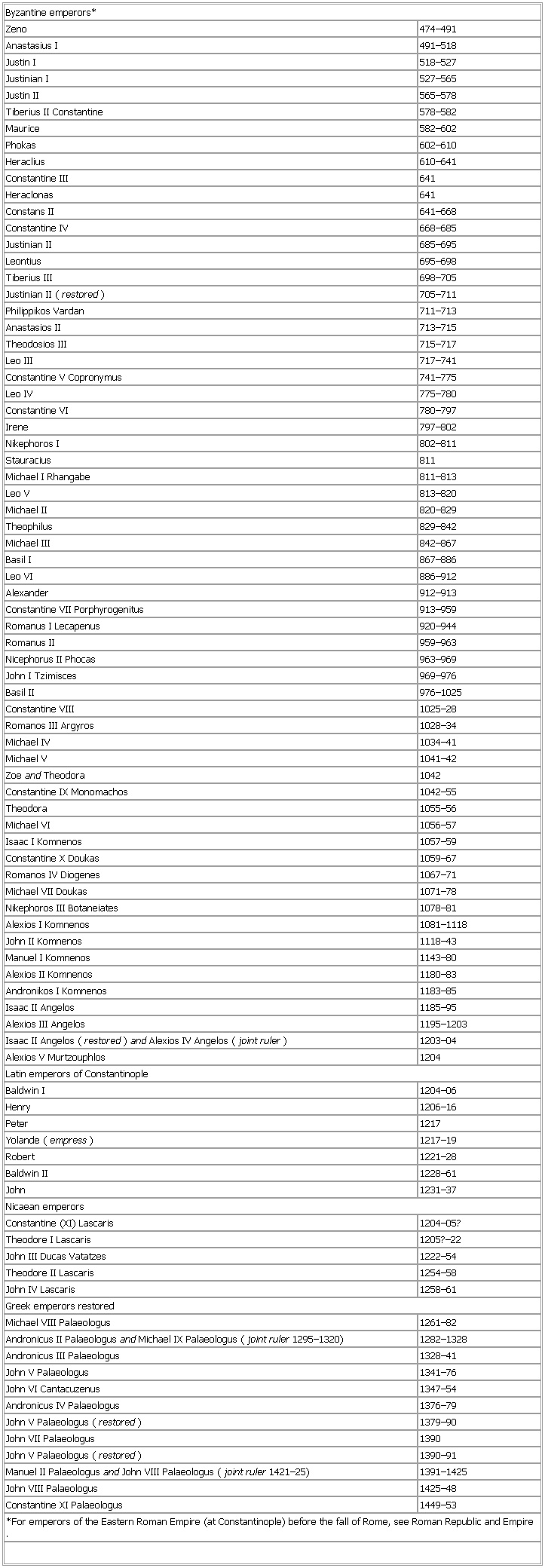- Byzantine emperors*
-
▪ TableByzantine emperors*Zeno 474–491Anastasius I 491–518Justin I 518–527Justinian I 527–565Justin II 565–578Tiberius II Constantine (Tiberius II Constantinus) 578–582Maurice 582–602Phokas (Phocas) 602–610Heraclius 610–641Constantine III 641Heraclonas 641Constans II (Constans II Pogonatus) 641–668Constantine IV 668–685Justinian II 685–695Leontius 695–698Tiberius III 698–705) (Justinian II) 705–711Philippikos Vardan (Philippicus Bardanes) 711–713Anastasios II (Anastasius II) 713–715Theodosios III (Theodosius III) 715–717Leo III 717–741Constantine V Copronymus 741–775Leo IV 775–780Constantine VI 780–797Irene 797–802Nikephoros I (Nicephorus I) 802–811Stauracius 811Michael I Rhangabe 811–813Leo V 813–820Michael II 820–829Theophilus 829–842Michael III 842–867Basil I 867–886Leo VI 886–912Alexander 912–913Constantine VII Porphyrogenitus 913–959Romanus I Lecapenus 920–944Romanus II 959–963Nicephorus II Phocas 963–969John I Tzimisces 969–976Basil II 976–1025Constantine VIII 1025–28Romanos III Argyros (Romanus III Argyrus) 1028–34Michael IV 1034–41Michael V (Michael V Calaphates) 1041–42Constantine IX Monomachos (Constantine IX Monomachus) 1042–55Theodora 1055–56Michael VI (Michael VI Stratioticus) 1056–57Isaac I Komnenos (Isaac I Comnenus) 1057–59Constantine X Doukas (Constantine X Ducas) 1059–67Romanos IV Diogenes (Romanus IV Diogenes) 1067–71Michael VII Doukas (Michael VII Ducas) 1071–78Nikephoros III Botaneiates (Nicephorus III Botaneiates) 1078–81Alexios I Komnenos (Alexius I Comnenus) 1081–1118John II Komnenos (John II Comnenus) 1118–43Manuel I Komnenos (Manuel I Comnenus) 1143–80Alexios II Komnenos (Alexius II Comnenus) 1180–83Andronikos I Komnenos (Andronicus I Comnenus) 1183–85Isaac II Angelos (Isaac II Angelus) 1185–95Alexios III Angelos (Alexius III Angelus) 1195–1203) (Isaac II Angelus) and ) (Alexius IV Angelus) 1203–04Alexios V Murtzouphlos (Alexius V Ducas Mourtzouphlus) 1204Latin emperors of ConstantinopleBaldwin I 1204–06Henry (Henry of Hainault) 1206–16Peter 1217Yolande (empress) 1217–19Robert 1221–28Baldwin II (Baldwin II Porphyrogenitus) 1228–61John 1231–37Nicaean emperorsTheodore I Lascaris 1205?–22John III Ducas Vatatzes 1222–54Theodore II Lascaris 1254–58John IV Lascaris 1258–61Greek emperors restoredMichael VIII Palaeologus 1261–82Andronicus II Palaeologus and joint ruler (Michael IX Palaeologus) 1295–1320) 1282–1328Andronicus III Palaeologus 1328–41John V Palaeologus 1341–76John VI Cantacuzenus 1347–54Andronicus IV Palaeologus 1376–79) (John V Palaeologus) 1379–90John VII Palaeologus 1390) (John V Palaeologus) 1390–91Manuel II Palaeologus and joint ruler (John VIII Palaeologus) 1421–25) 1391–1425John VIII Palaeologus 1425–48Constantine XI Palaeologus 1449–53*For emperors of the Eastern Roman Empire (at Constantinople) before the fall of Rome, see Roman Republic and Empire.See as table:

* * *
Universalium. 2010.
